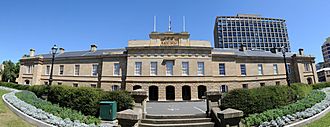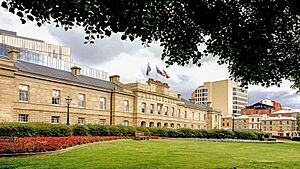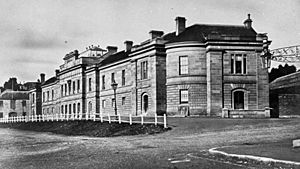Parliament House, Hobart facts for kids
Quick facts for kids Parliament House |
|
|---|---|

Panoramic View of Hobart Parliament House from the front steps
|
|
| General information | |
| Architectural style | Colonial Georgian architecture |
| Town or city | Hobart, Tasmania |
| Country | Australia |
| Coordinates | 42°53′08″S 147°19′49″E / 42.885449°S 147.330362°E |
| Construction started | 5 January 1835 |
| Completed | 1 September 1840 |
| Client | Parliament of Tasmania |
| Design and construction | |
| Architect | John Lee Archer |
Parliament House, Hobart is a very important building in Hobart, Tasmania, Australia. It's where the Parliament of Tasmania meets to make laws for the state.
This building wasn't always a parliament. It was first built to be a customs house, which is where taxes on goods coming into the country were collected. In 1841, Tasmania started to govern itself more, and the building became home to the parliament as well. It served both purposes until 1904, when the customs offices moved out.
Contents
The Story of Parliament House
How Tasmania Gained Self-Government
In 1803, the island of Tasmania, then called Van Diemen's Land, was settled by Great Britain. At first, it was managed by the Governor of New South Wales. But in 1825, Tasmania became its own British colony.
A group called the Legislative Council was created. It had six men who were chosen to give advice to the Lieutenant Governor. They met in a room near the old Government House. By 1841, they moved their meetings to a large room in the new Customs House.
In 1850, the British Parliament passed a law that allowed Van Diemen's Land to elect its own government. The Legislative Council grew to 24 members. Sixteen members were elected by people who owned property, and eight were chosen by the Governor.
This new council met in 1852. By 1854, they created the Tasmanian Constitution Act. This act gave Van Diemen's Land the right to govern itself with a new two-part parliament. In 1855, Queen Victoria agreed to this, and Van Diemen's Land became a self-governing British colony.
One of the first things the new parliament did in 1856 was change the colony's name. It went from Van Diemen's Land to Tasmania.
Building Changes for the New Parliament
In April 1856, work began to change the Customs House. This was to make space for the new two-part parliament. On December 2, 1856, the first parliament meetings were held there. The new House of Assembly met in the Long Room. The Legislative Council moved to its own new room at the other end of the building.
Tasmania continued to be an independent colony until January 1, 1901. On this date, Tasmania joined five other Australian colonies. They all came together to form the new Commonwealth of Australia. The Tasmanian colonial parliament then became the Tasmanian State Parliament. It still handles local issues like education, health, and policing today.
Building Parliament House
Designing and Constructing the Building
Parliament House was designed by a skilled architect named John Lee Archer in 1830. It was built in the Colonial Georgian architecture style. The spot where it stands was once a market, then a timber yard. In 1832, it was chosen for the Customs House because it was close to the docks of Sullivans Cove.
Between 1832 and 1840, golden sandstone was dug from places like Queens Domain and Salamanca Place. A small railway was built to carry the stone blocks to the construction site. Building started on January 5, 1835. Mostly convict workers helped build it. The basement was finished by March 1836. By 1838, the second story was added. Customs staff moved in on September 1, 1840.
From Customs House to Parliament
By 1841, the building was busy as the colony's customs house. The Legislative Council needed a better place to meet. They decided the large 'Long Room' in the Customs House would be perfect. On June 19, 1841, the first Legislative Council meeting was held there.
After Tasmania gained self-government in 1856, the building was changed again. This was to fit the new two-part parliament. The new House of Assembly met in the Long Room. The Legislative Council moved into a special new room, where they still meet today.
The Customs Department finally left the building in 1904. They moved to a new spot in Davey Street. This left Parliament House entirely for the Parliament of Tasmania.
Modern Updates and Features
Between 1938 and 1940, Parliament House was updated again. A new room was built for the House of Assembly. The Long Room, where they had met for 82 years, became a Members' Lounge. The new House of Assembly Chamber opened on May 14, 1940. Extensions were also added to the Legislative Council Chamber in December 1940.
More changes happened starting in 1977. Offices for members, a library, committee rooms, a dining room, and other facilities were added. A formal re-opening took place on April 16, 1980. Since 1998, conservation work has been ongoing to restore parts of the building to their original look.
The Royal coat of arms of the United Kingdom can be seen all over Parliament House. It's in stained-glass windows and carvings. This shows that Tasmania was once a British colony. Tasmania used the Royal Arms on official papers until 1953, even after getting its own coat of arms in 1919.
The Legislative Council
Role of the Upper House
The Legislative Council is known as the Upper House. It reviews proposed laws, called bills, that have already been approved by the House of Assembly. If the Legislative Council also approves a bill, it becomes an act of parliament. Then, the Governor of Tasmania gives it royal assent, which means it officially becomes a law.
The Legislative Council is the older part of Tasmania's government. It first met in 1825 and has been part of the government ever since. It started as a small group of six men chosen by the Lieutenant Governor. In 1850, it grew to 24 members. In 1856, when the current two-part parliament was set up, it was reduced to 15 members. The person in charge of the Legislative Council is called the President of the Tasmanian Legislative Council.
Elections and Members
Elections for the Legislative Council happen every six years. Tasmania is divided into 15 areas, called electoral divisions. One member is elected from each area. These 15 members are called 'Members of the Legislative Council' (MLCs).
Inside the Legislative Council Chamber
The Legislative Council originally met in a room in the old Government House. When Parliament House opened, they moved to the Long Room. In 1856, a special Legislative Council chamber was built for them. This room is decorated with red colors, seating, and carpet. It has beautiful cedar wooden panels on the walls. The wooden panels and ceiling are hand-stenciled with amazing designs.
The President sits in a large chair at one end of the room. Members sit in two rows along the walls, facing each other. Seats to the President's right are for special guests. To the left is where the press sits. There is also a public gallery where people can watch the council meet. A Black Rod is in the chamber. This is a symbol of royal authority for the Upper House. A large painting of Queen Victoria hangs on a side wall. It honors her role in giving Tasmania self-government.
Queen Elizabeth II, who was the Queen of Australia, sat in the President's Chair. She officially opened the Tasmania Parliament on February 22, 1954. This was the only time the Tasmanian Parliament has been officially opened by its head of state.
The House of Assembly
Role of the Lower House
The Tasmanian House of Assembly was created in 1856. This was when Tasmania adopted self-government. Tasmania chose a government system like the United Kingdom, with a two-part parliament. The House of Assembly is like the House of Commons in the UK. It is made up entirely of elected members.
This means the House of Assembly is the Lower House. New bills are first written and discussed here. Then, they are passed up to the Legislative Council for review. This system still works the same way today.
Elections and Members
When it first started, the House of Assembly had 30 members from 24 areas. Hobart had five members, and Launceston had two. All other areas had one member.
After Australia became a federation, the House of Assembly was reduced to 30 members. The old areas were replaced with five new federal areas: Braddon, Bass, Franklin, Lyons, and Denison. Tasmania is the only Australian state that uses its federal electorates for its state lower house. Each area now elects seven members, making a total of 35 members. These members are called Members of the House of Assembly (MHAs). They are elected for four years using a special voting system called Hare-Clark.
Inside the House of Assembly Chamber
When it was first formed in 1856, the House of Assembly met in the Long Room. This was the room the Legislative Council had just left. In 1940, the current House of Assembly Chamber was built. It has green decorations, seating, and carpet. There are blackwood wooden panels around the walls.
The Speaker of the Tasmanian House of Assembly sits in a raised chair at one end of the room. All the members sit in a horseshoe shape, facing the Speaker. Three clerks sit in front of the Speaker. Usually, the Premier of Tasmania and the party in charge sit to the Speaker's right. The opposition party sits on the other side of the horseshoe. A ceremonial mace is placed next to the Speaker. This is a symbol of authority. There is also a public gallery where people can watch their government in action.
See also




